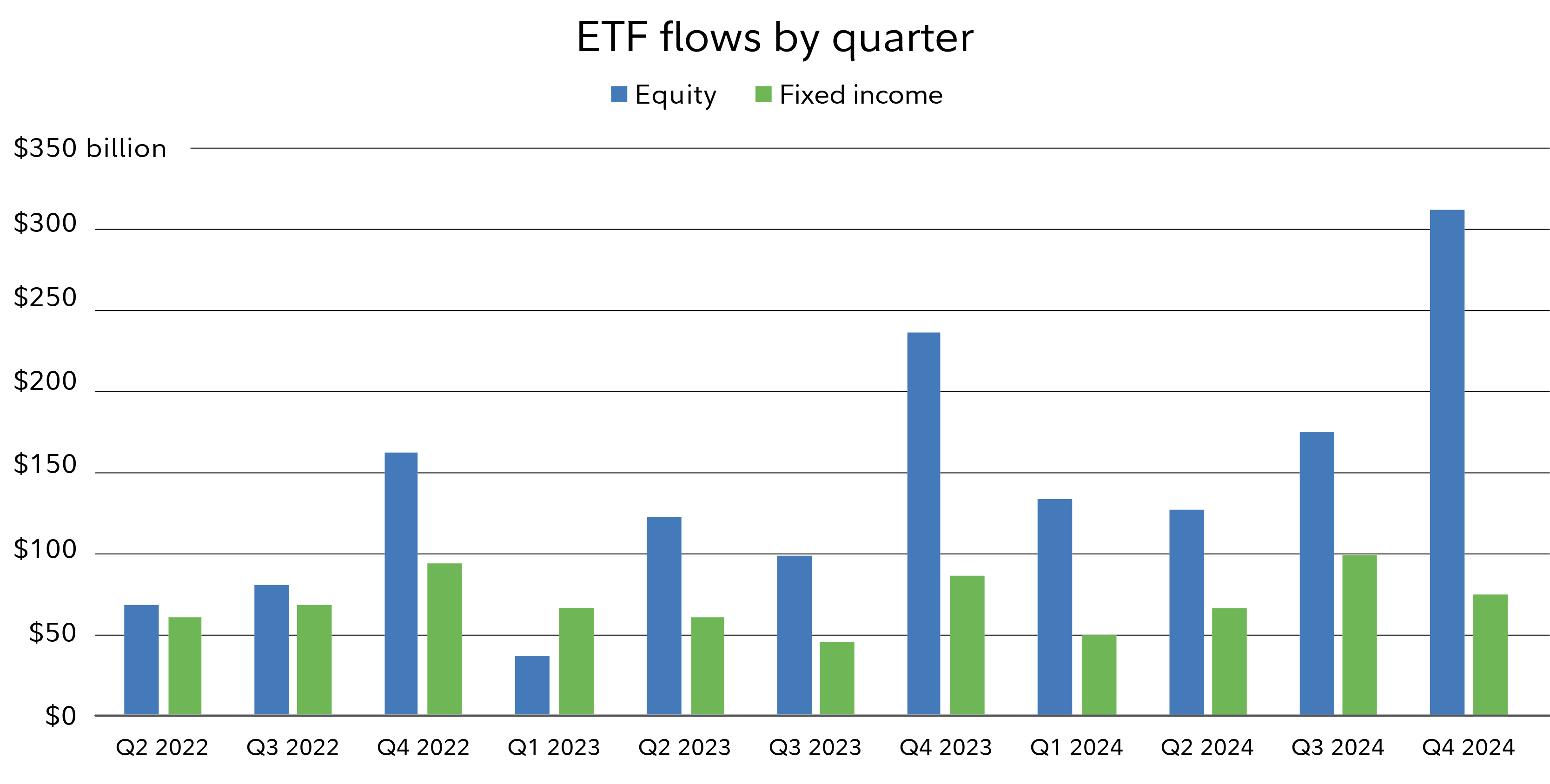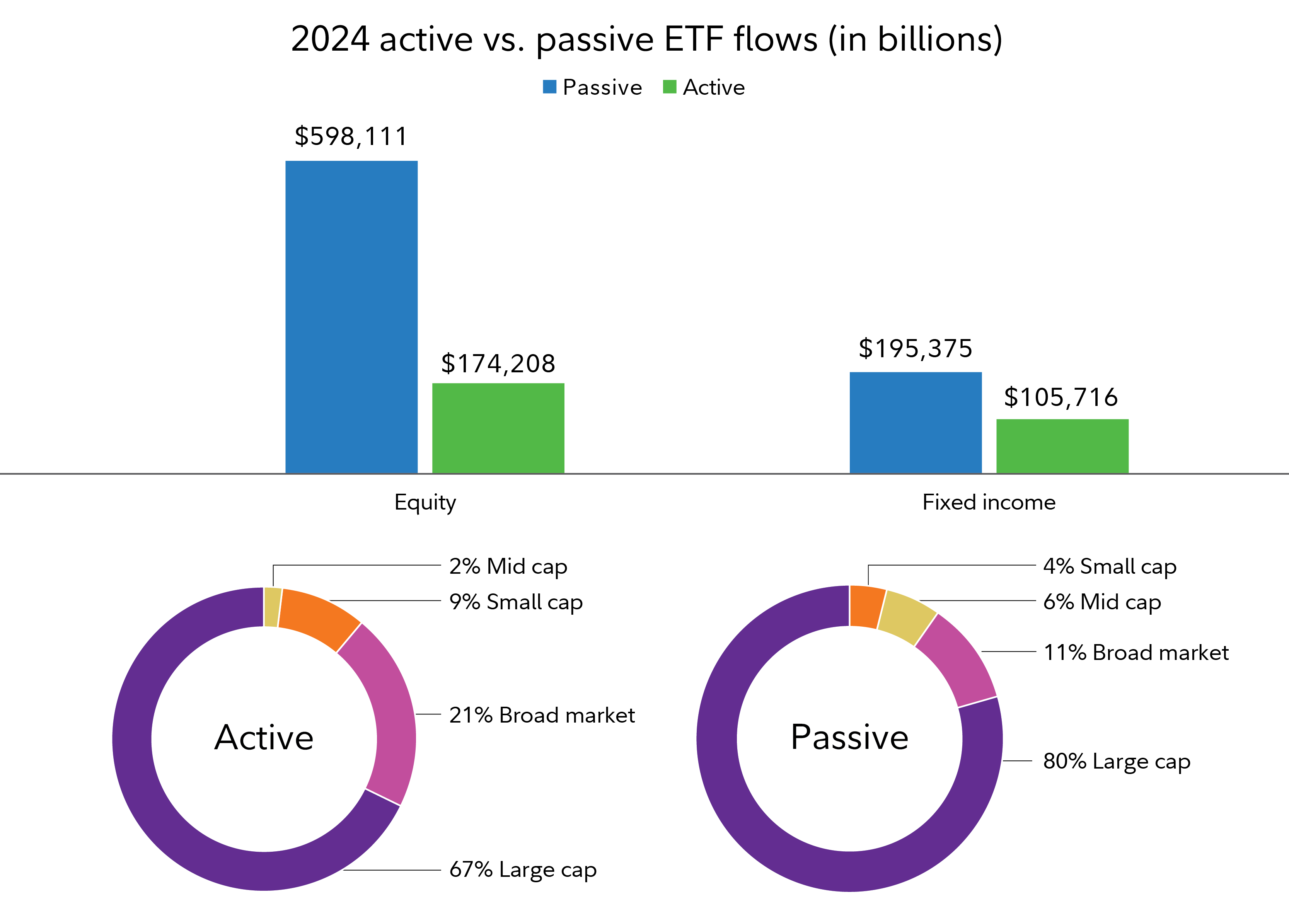Multiple records were set by ETFs in 2024. Not only was it the biggest year for net flows (i.e., inflows less outflows), but total assets under management reached $10.4 trillion across more than 3,800 products.
Here were the biggest trends in ETF flows last year and where the momentum was at the outset of 2025.
Tidal wave of flows closed 2024
The record-setting year was enabled by an enormous second half. ETFs gathered $312 billion in net flows during Q4, after accumulating $292 billion during Q3. That brought 2024’s total cume to $1.1 trillion—an 89% increase over 2023, when ETFs accumulated roughly $600 billion. 2024’s total also topped the previous ETF flows annual record of just under $1 trillion in 2021.
Equity (e.g., stock) ETFs led all categories during the year, bringing in $722 billion in flows, led by broad-based index funds. As stock markets rallied to record highs, Q4 saw equity ETFs accrue an astounding $312 billion in flows.

Within equity ETFs, sector-themed ETFs saw disparity heading into 2025. Q4 ETF flows were overwhelmingly positive for financials ($8.2 billion), tech ($6.5 billion), and industrials ($3.9 billion), while health care (-$3.4 billion), consumer staples (-$847 million), and real estate (-$625 million) ETFs experienced outflows.
On the fixed income (e.g., bond) ETF flows side, it was another year of strong momentum. Even though equity ETF flows have outpaced fixed income ETF flows 7 consecutive quarters, it was a huge year for the latter category. The $75 billion accumulated during Q4 fell short of Q3’s big haul, but combined, the 2 quarters helped propel fixed income ETFs to a $301 billion cume in 2024.
Fixed income flows were led by aggregate bond ETFs ($127 billion) and corporate bond ETFs ($57 billion). Additionally, intermediate/long-duration ETF flows accounted for $89 billion, while short/ultrashort ETFs had $37 billion in flows.
Active flows underpin big year, crypto ETFs springboard
Of the ETF trends that prevailed during 2024, the ongoing growth of actively managed ETFs as well as the emergence of cryptocurrency ETFs stood out.
Actively managed ETFs, which in contrast to passively managed ETFs are not designed to track a benchmark, accounted for 27% ($299 billion) of ETF industry inflows, even though they only accounted for 9% of assets. Of the 723 ETFs that were launched in 2024 (a new annual record), 575 were actively managed ETFs.
By market cap, flows were concentrated in large caps—particularly for passively managed ETFs. That was followed by flows into broad-market ETFs (i.e., those with exposure to multiple cap sizes), small caps, and finally mid caps.

On the crypto ETF front, it was a banner year. The 9 spot bitcoin exchange-traded products (ETPs) launched in January gathered $56 billion of inflows during 2024.1 Crypto ETPs (ETFs are a type of ETP) give you direct exposure to the price of a cryptocurrency without needing to actually buy the coin directly. Spot bitcoin ETPs are the first exchange-traded products that track the price of bitcoin by holding actual bitcoin (i.e., “spot”) as their underlying assets.
Riding 2024’s crypto momentum, crypto ETPs debuted to massive demand and several were among the top-performing ETFs in terms of price performance during the year.
Looking for ETFs?
ETF flows can be a useful tool to help identify market trends, and to see where investors are broadly putting their money. If you are interested in investing in ETFs, Fidelity's ETF Screener can quickly sort through a lot of data based on the filtering selections you make.
You can search for ETFs using a variety of characteristics, like the fund's objectives, fundamentals, technicals, performance, volatility, trading characteristics, tax considerations, and analyst ratings.


